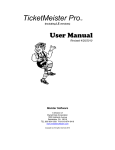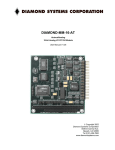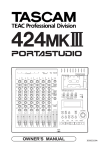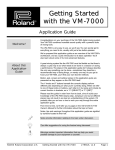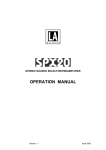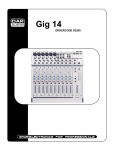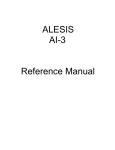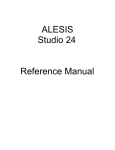Download Alesis ADAT-M20 EC-1 Owner`s manual
Transcript
ALESIS EC-1 AES/EBU INTERFACE CARD FOR THE M20 PROFESSIONAL 20-BIT DIGITAL RECORDER OWNER’S MANUAL FIRST EDITION VERSION 1.00 APPLIES TO M20 OPERATING SOFTWARE VERSION 1.11 1998 ALESIS CORPORATION EC-1 AES/EBU Interface, Appendix E EC-1 MANUAL 1.00 APPENDIX E EC-1 AES/EBU INTERFACE This document covers only those aspects unique to the EC-1 card and should be inserted into the binder with the M20 manual. TABLE OF CONTENTS Important Safety Instructions..............................................................................................................2 Safety symbols used in this product ...................................................................................................2 CE Declaration of Conformity.............................................................................................................2 About the EC-1 .....................................................................................................................................4 Overview of Main Functions ...............................................................................................................5 About AES/EBU Digital Audio.............................................................................................5 Digital Audio Cables ..............................................................................................................5 Front Panel Setup..................................................................................................................................5 Installation.............................................................................................................................................6 Precautions ..............................................................................................................................6 EC-1 Connection to M20 Main Circuit Board.......................................................................6 Basic Operation.....................................................................................................................................7 Selecting AES/EBU (I/O Card) as the Digital Source .........................................................7 Selecting AES/EBU (I/O Card) as the Clock Source...........................................................7 To select AES/EBU as the clock source: ...............................................................................7 If the EC-1 is not installed in the master M20:......................................................................8 Input Routing using AES/EBU (I/O Card) as the Digital Source ......................................8 If the input selection is analog and AES/EBU simultaneously:..........................................9 Editing input routing when the input selection is analog and AES/EBU simultaneously: .......................................................................................................................9 EC-1 MANUAL 1.00 E-1 EC-1 AES/EBU Interface, Appendix E IMPORTANT SAFETY INSTRUCTIONS SAFETY SYMBOLS USED IN THIS PRODUCT This symbol alerts the user that there are important operating and maintenance instructions in the literature accompanying this unit. This symbol warns the user of uninsulated voltage within the unit that can cause dangerous electric shocks. All safety warnings in the M20 manual (pages v and vi) apply to the EC-1 as well. CE DECLARATION OF CONFORMITY Manufacturer’s Name: Alesis Corporation Manufacturer’s Address: 1633 26th Street Santa Monica, CA 90404 USA declares, that the product: Product Name: Product Type: Recorder EC-1 Expansion Card for Digital Multitrack conforms to the following Standards: Application of Council Directive: 89/336/EEC; 73/23/EEC Safety: Exempt from Low Voltage Directive EMC: EN 55022:1995 Class A, EN50082-1:1992 (IEC 801-2:1991 2nd Edition, 4kV direct, 8kV air IEC 801-3:1984 2; 3V/m 150MHz-1GHz IEC 801-4:1988 1st Edition 2; 1kV, 0.5kV) All tests were performed with fully-shielded cabling. European Contact: E-2 Sound Technology plc Letchworth Point Letchworth Hertfordshire, SG6 1ND UNITED KINGDOM Phone: +44.1462.480000 Fax: +44.1462.480800 EC-1 MANUAL 1.00 Appendix E, EC-1 AES/EBU Interface October, 1998 EC-1 MANUAL 1.00 E-3 EC-1 AES/EBU Interface, Appendix E ABOUT THE EC-1 The EC-1 is an optional AES/EBU protocol expansion card designed exclusively for the M20. It provides 8 simultaneous channels of AES/EBU digital audio inputs and outputs via eight XLR type jacks (four input channel pairs and four output channel pairs). The EC-1 may be installed directly into the M20’s rear panel for simple system integration and flexibility. With the EC-1 installed, the M20 can receive and transmit AES/EBU digital audio and digital reference clock. The EC-1 expansion card is designed for use only with M20 software version 1.11 or higher. If your M20 has a lower software version, contact Alesis Technical Support at (800) 5-ALESIS or visit our web site at www.alesis.com to download the latest M20 software in the form of a standard MIDI file. You will find instructions for updating the M20 on the web site as well. The EC-1 features: E-4 • 8 channels of AES/EBU digital audio. 8 channels of simultaneous input and output available on XLR jacks. • Simple hookup and operation. The EC-1 is designed to install in the rear panel of the M20 and connects to the main circuit board with the included multi-pin ribbon connector. Once connected, the M20 will detect the card’s presence thereby allowing digital audio I/O configurations using AES/EBU as the digital audio source with digital input routing. AES/EBU channel pairs can be selected as a clock source as well. EC-1 MANUAL 1.00 Appendix E, EC-1 AES/EBU Interface OVERVIEW OF MAIN FUNCTIONS ABOUT AES/EBU DIGITAL AUDIO The AES/EBU protocol is the most common professional standard for transmitting digital audio. It is a two-channel protocol designed for stereo pairs, so transmitting from the eight-channel ADAT M20 requires the use of four sets of AES/EBU jacks: four XLR male jacks for output, and four XLR female jacks for input. The AES/EBU input jacks may be routed (or “normalled”) to multiple ADAT tracks using the M20’s INPUT ROUTING feature. The AES/EBU output jacks are always active, outputting the data from their samenumbered track, in addition to the always-active ADAT Optical outputs, so it is possible to output digital signals to several destinations simultaneously. As with all digital audio interchange formats, AES/EBU transmits audio encoded as numbers, which may only be received by another digital unit. Do not plug any AES/EBU signals into an analog audio device (such as a microphone input). Avoid running AES/EBU signals through a patch bay or cable snake that also handles analog audio signals. Noise and improper operation may result. The AES/EBU protocol has an embedded clock so that the transmitter and receiver can lock onto the exact same sample rate. In simple setups, this is automatic: the device receiving AES/EBU simply follows the incoming clock (for example, recording from a single CD in stereo). But in multitrack applications such as the M20, you must design your system with the “one clock” limitation in mind. When recording multiple AES/EBU inputs, all inputs being recorded must be referenced to the same clock. For example, you cannot record into the M20 from a CD player, a DAT, and a digital sampler simultaneously, unless all of these devices are synchronous, i.e., set to use a single master word clock as their reference. For more information on setting the clock source, refer to the M20 manual chapter 15, tutorial 3 (Digital Clock Considerations). DIGITAL AUDIO CABLES AES/EBU is a high-frequency digital interface with some harmonics of its signal extending into the radio range. While high-quality standard microphone cables may be used, in some situations specially-designed cables may be required. Especially in long cable runs, cable with a specified impedance of 110 ohms may be required. Check with your dealer for more information. FRONT PANEL SETUP After installation, the EC-1 card can be selected as a digital input source and clock reference via the M20’s front panel. Input routing can be applied to the AES/EBU input as well. The AES/EBU outputs are always available, no matter what input source is selected. EC-1 MANUAL 1.00 E-5 EC-1 AES/EBU Interface, Appendix E INSTALLATION PRECAUTIONS Install the EC-1 only if you have had some experience with similar devices and feel competent to do so. If the following instructions are not clear to you, have your dealer or a trained technician install it for you. Hazardous voltages are present within the chassis. Do not remove the top panel without first unplugging the unit from AC power! EC-1 CONNECTION TO M20 MAIN CIRCUIT BOARD The EC-1 comes with a 40-pin flexible cable. The cable should be attached to the multi-pin header on the card with the blue side of the cable facing away from the XLR connectors. To connect the EC-1 to the M20: 1. Remove the top panel from the M20. The top panel is held to the rear panel with two Philips head screws. 2. Remove the expansion slot blank panel from the M20 rear panel. Four screws keep the blank panel in place. It is best to hold the blank panel in place when removing the screws to prevent the blank from dropping onto the main circuit board. 3. Insert the ribbon connector into the 40-pin header on the main circuit board. The header is labeled “J7” and sits to the right of the chip labeled “2-32-0007 SMPTE FPGA”. The blue side of the cable should face the front of the M20. 4. Screw the EC-1 card into the expansion slot from the inside of the M20. Use the four screws that held the blank panel in place. 5. Replace the top panel. To test for proper installation, plug the unit back in to AC power, turn on the M20, and press the Digital Source button (next to the meter display) until the “DIG SOURCE” group in the meter display indicates “I/O CARD”. This confirms that the M20 has detected the EC-1’s presence. E-6 EC-1 MANUAL 1.00 Appendix E, EC-1 AES/EBU Interface BASIC OPERATION SELECTING AES/EBU (I/O CARD) AS THE DIGITAL SOURCE When using digital inputs, the Digital Source function selects one of three digital input options. The I/O CARD option will appear in the display only if an I/O card (such as the Alesis EC-1 card) is installed in the M20. With the EC-1 card installed, pressing the Digital Source button (next to the meter display) toggles through the available sources, such as ADAT OPTICAL, TRACK COPY, and I/O CARD. To select AES/EBU as the digital source, press the Digital Source button until I/O CARD appears in the DIG SOURCE group of the meter display. Now, when Input Select mode is set to digital input for a given channel pair (and dependent on how input routing is configured), an AES/EBU input will be the source for the selected channels. SELECTING AES/EBU (I/O CARD) AS THE CLOCK SOURCE If a word clock, video, or optical clock source that is synchronous to AES/EBU digital audio input is not available, sample clock for the M20 can be derived from any of the four AES/EBU input channel pairs. TO SELECT AES/EBU AS THE CLOCK SOURCE: 1. Press the Clock Source button (under the main display) until I/O CARD appears in the CLOCK SOURCE group of the main display. 2. When I/O Card is selected, the alpha-numeric in the main display will indicate, “AES Clk Source: Chan 1/2”. This implies that the M20 will look for clock input at the channel pair 1 and 2 XLR input. If AES/EBU clock input is not detected, the I/O CARD indicator will flash and the M20’s internal clock will be used until valid AES/EBU input is detected. 3. To select the AES clock source, use the Up/Down arrows on the keypad. The selections are Chan 1/2, Chan 3/4, Chan 5/6, or Chan 7/8. As noted earlier, if recording multiple AES/EBU pairs, their clocks must be synchronous to avoid “ticks” and “pops” or audio distortion. If you have multiple synchronous inputs (for example, from a single digital mixer), it does not matter which channel pair is chosen as the clock source. Example: Suppose you set the digital source to I/O CARD, and set the input selection for channels 3 and 4 to digital (shown by the “D” illuminated under those channel meters on the M20). Input 3/4 on the EC-1 card is the only jack connected to an AES/EBU digital audio source (like a DAT recorder). If no other AES/EBUsynchronous external clock source is available, I/O CARD must be selected as the clock source. But when you do this, the clock source I/O CARD indicator flashes, and audio monitored via the M20 is distorted. Why? Because there still is not a valid clock. The M20’s default AES/EBU clock source is channel pair 1/2. But in this example, channel pair 3/4 is the only AES/EBU input present, so the M20 tries to use its internal clock. Since there is no connection between the M20’s internal clock and the internal clock of the DAT feeding it in this case, the numbers that make up the digital transfer are arriving in the wrong positions, causing the distortion. The cure? Simply set the AES clock source to “Chan 3/4" (or whatever channels you’re using), or plug the AES/EBU source into channel pair 1/2. EC-1 MANUAL 1.00 E-7 EC-1 AES/EBU Interface, Appendix E Once again, we must remind you: if independent (non-synchronous) AES/EBU sources are connected to the EC-1 card, audio cannot be monitored (or recorded) simultaneously since the clock for each input channel pair is independent. When monitoring AES/EBU digital audio from more than one channel pair, all of the AES/EBU sources must be synchronous, i.e., controlled by the same sample clock. IF THE EC-1 IS NOT INSTALLED IN THE MASTER M20: If the EC-1 card is installed in a slave M20 (e.g. ID 2), the only clock source available will be ADAT (the clock coming in through the ADAT Sync In jack). In this case, AES/EBU input to the slave must be synchronous to the master (ID 1) M20 to avoid clocking problems. This is where the use of synchronous word clock (or other applicable external clock source) into the master M20 is an appropriate solution. Note: In typical scenarios where ADAT optical is used as the digital input source, the “D” indicators beneath each channel’s meter segments will remain solid to indicate that digital audio input for the selected source is present. If ADAT optical signal is not detected, the “D”s flash as a warning. When a valid external (synchronous) clock source other than I/O CARD (e.g. WORD CLOCK) is used with an AES/EBU digital audio input, the “D” indicators will always remain solid even though AES/EBU signal may not be present. INPUT ROUTING USING AES/EBU (I/O CARD) SOURCE AS THE DIGITAL The Input Routing feature of the M20 allows you to go from any input to any track without the need for repatching. Just as the analog Input Routing feature allows you to do that with an analog input, you can do the same for AES/EBU inputs from the EC-1 card. AES/EBU routing accommodates a 2-, 4-, or 8-bus mixing configuration. You have the following AES/EBU routing choices when the digital source = I/O Card: E-8 • Odd/Even (2-bus feed): Press INPUT ROUTING and either the Track 1 or 2 button. Input 1 feeds channels 1, 3, 5, 7, and Input 2 feeds channels 2, 4, 6, 8. To record on an odd-numbered track, route the signal(s) to bus #1 or left. To record onto an even-numbered track, route the signal(s) to bus #2 or right. By simply putting the desired track into record, the proper signal will get there, even though it is not connected directly to the track’s input jack. • Half & Half (4-bus feed): Press INPUT ROUTING and either the Track 3 or 4 button. Input 1 feeds channels 1, 5; input 2 feeds 2, 6; input 3 feeds 3, 7; input 4 feeds 4, 8). To record on tracks 1 or 5, route the signal(s) to bus #1. Likewise, to record onto tracks 2 or 6, route the signal(s) to bus #2, and so on. • One-to-one (8-bus feed): Press either the Track 5, 6, 7, or 8 button in Input Routing mode. This is the power-on default, where each input feeds its corresponding channel. To record on track 1, send the signal to mixer bus 1, to record on track 2 send the signal to mixer bus 2, etc. This is also the recommended mode when feeding the M20 from a mixer channels’ direct outs. EC-1 MANUAL 1.00 Appendix E, EC-1 AES/EBU Interface Note: The above illustrations assume that the source tracks of the M20 are set to receive digital input (as shown by a “D” under the meter for each track). IF THE INPUT SELECTION IS ANALOG AND AES/EBU SIMULTANEOUSLY: If you have INPUT SELECT configured for analog and AES/EBU input, input routing must use the one-to-one configuration. This is the case because using any other bus configuration will route the selected I/O card digital source tracks (e.g. tracks 1 and 2 using odd/even routing) to all input enabled tracks even when the input enabled tracks are set to analog input, i.e., all input enabled tracks become I/O card destination tracks. EDITING INPUT ROUTING WHEN THE INPUT SELECTION IS ANALOG AND AES/EBU SIMULTANEOUSLY: If you have INPUT SELECT configured for analog and AES/EBU input, editing the input routing is limited to selecting I/O card source tracks only. The analog input routing will not be editable and will follow (be the same as) the I/O Card routing. If the you want to edit analog input routing, the digital source cannot be I/O Card. The scenario below describes a mixed signal input using I/O CARD as the digital source: Example: You are recording a digital submix patched into AES/EBU input pair 1/2 and intend to route this input to channels 3 and 4. You also have an analog submix patched into the analog inputs for channels 7 and 8. The M20 is configured as follows: The DIGITAL SOURCE is I/O CARD. INPUT ROUTING uses the "odd/even" configuration (channels 1 and 2 are the digital source tracks). INPUT SELECT is set to DIGITAL input for channels 1 through 4; and ANALOG input for channels 5 through 8. Channels 3, 4, 7 and 8 are input enabled. Channels 3 and 4 will monitor the AES/EBU input as expected (the “D” under each meter seems to make this obvious). Channels 7 and 8 will also monitor AES/EBU input (not the direct analog input) because the M20 is being told to bus channels 1 and 2 to ANY input enabled track(s). You cannot use odd/even or half & half input routing with AES/EBU input and monitor analog inputs simultaneously. To monitor the analog inputs for channels 7 and 8 together with AES/EBU input, INPUT ROUTING must use the one-to-one routing configuration. In this case however, AES/EBU input into channel pair 1/2 will not route to channels 3 and 4. EC-1 MANUAL 1.00 E-9 EC-1 AES/EBU Interface, Appendix E E-10 EC-1 MANUAL 1.00












